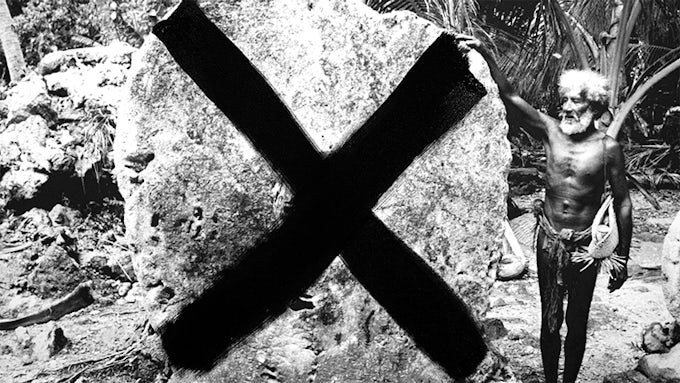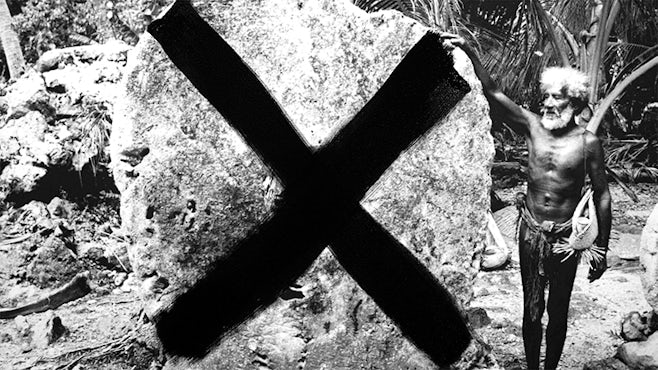
Nicholas Mangan’s work gives form to complex histories and relationships between matter and energy. His installation practice incorporates sculptural objects and environments, film, sound and evolving and contingent systems that act to generate and sustain his work through time. His most recent project, Limits to Growth (2016/17), is a generative project that draws on the history of materials and labour in order to explore the evolution of money and notions of value, from stone coins from the Pacific island of Yap to cryptocurrencies such as Bitcoin.01 The following conversation considers his expanded practice as a way of thinking through images, sounds and materials.
George Clark: Limits to Growth proposes new ways of thinking about your practice. I would like to start via an earlier work, Ancient Lights (2015). Could you introduce that project?
Nicholas Mangan : Ancient Lights is a two-channel video with sound that’s powered by an off-grid solar energy supply. The solar panels are out in the courtyard, and the energy is fed into the space through these off-grid solar batteries that in turn power the projectors and the single-channel sound. This work has no narration and has a series of overlapping images that work as a kind of montage. The project was a way of harnessing energy from the sun and light and turning that into electricity and turning that back into projected light again.
GC: The narrative elements in the work are dependent on the processes of interpretation, as the work looks at the reading of scientific data against social and economic developments. These economic systems are central to Limits to Growth. Can you talk about the origins of this project?
NM: Limits to Growth is in many ways a site-specific work. In the first installation at Monash University of Modern Art on one of the screens you can see live CCTV footage of a Bitcoin mining rig that is down in the basement of Melbourne University where the air-conditioning supply is housed. On the other monitor is footage I had shot on the island of Yap in January 2016 on a GoPro camera. The footage is of a Yap stone that was recently unearthed at the bottom of a seabed just off the coast. In this work I’m mining Bitcoin in the basement and using that Bitcoin to pay for the reproduction of the photographs that are added to the exhibition, so the work is in the process of production throughout the show. Early on I was looking at this idea as a very slow form of film-making, like one image and one frame, so it’s very much an economical film in that regard.
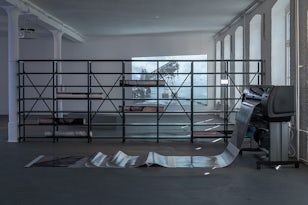
GC: The evolving system you have developed for Limits to Growth stands in contrast to the closed system you developed for Ancient Lights.
NM: With Ancient Lights if there’s not enough sunlight there’s a risk that it won’t function. I’m asking: what is progress in terms of human agency, matter and energy? With the spinning coin, we all know that the coin should come to rest, and the work is really actively negating that. I have essentially got the two forces of thermodynamics going against each other. This kind of dance or play is a ‘micro’ way of illustrating this bigger idea of the Sun that is spinning around the earth and the idea that things are behaving in a way that’s not logical. In a way, Bitcoin behaves like a systematic apparatus – this was the other thing I was interested in, in terms of how the work operates structurally. For example Bitcoin works to avoid inflation, and has this thing called ‘halving’02 that is built into the software and means that machines can only produce half as much Bitcoin. It just so happens that during install that ‘halving’ system took place, so now the machine will only produce half as many images. I’m very interested in finding these parameters and contingencies that actually affect the limits of my works’ production.
GC: I want to ask about the depiction of labour in your earlier project Progress in Action (2013) and the relationships within different economic and political systems in that work?
NM: The work was inspired by one of the world’s first eco-revolutions that took place on the island of Bougainville, Papua New Guinea. The local people had a mine essentially forced upon them by the mainland Port Moresby in collaboration with Rio Tinto. At the time it was the largest open-pit copper mine in the world. You can see from these satellite images that the land damage was horrific and all of the tailings – the waste material – went down into the river and killed food supplies and displaced people. So a movement developed against the mine, which was dubbed ‘The Coconut Revolution’. In the work I was specifically interested in the idea of how these two forces of material extraction, copper/coconut, were going head to head. I didn’t go to the actual site in Papua New Guinea – the site of production was the Australian Archives where I found footage related to this resistance. It was covered in a number of propaganda videos made by the mining company, and it was also heavily covered by Australia Broadcasting Commission (ABC) at the time because of Australia’s involvement with it. Essentially the work for me was about taking this found footage and editing it into a new story. To further explicate this I adapted a diesel generator to run on 100% coconut oil. In this way the materials that are bound up in the story are a part of the system that makes the existence of the work possible. The objects you see in the installation are relics used by me to extract and refine the coconut oil. This project was an attempt at understanding what it takes in terms of labour and time to propel a resistance like this, and to refine one thing as a force in repelling another.
GC: The earliest project in the show is Nauru – Notes from a cretaceous world(2010). Can you talk about how you came to this island?
NM: In many ways this project was a very big shift for me from making discrete objects and predominantly sculptural installations. I would say it’s the first filmic work I made, and it felt necessary because it was the first time I was working with a history and context that I felt couldn’t just be contained in a single object. This work was a result of traveling to Nauru and exploring the gap between the two uses of the island from a period of intensive mining for phosphate deposits in the rock to it housing an off-shore detention centre as part of the Pacific Solution, which was established by John Howard. I was lucky to convince the Australian government to provide me with a visa to travel there. The work tells the story of how I came across these coral limestone pinnacles outside Nauru House in Melbourne. I actually knew nothing about the history of Nauru, and it was only through the discovery of these rocks that I began to enter into the history of Nauru and it just kept unfolding.
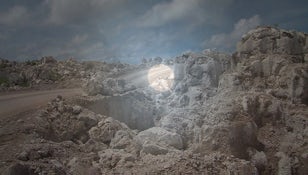
GC: Your project A World Undone(2012) is the most expansive in terms of time and brings up the important question of scale in your practice.
NM: I refer to that film as a sculpture. It’s the behaviour of matter and movement; it’s not about this idea of trying to capture something within a bigger timeframe. The rock is from a tectonic plate that contains some of the earliest earth form minerals like Zircon, which is carbon dated as 4.4 billion years old. What I wanted to do with this work was to try and explore this idea through opening it up, disaggregating it, but then seeing if I could get it to behave in a certain way, and that was a method of telling its story. What I found was that it was important to use an apparatus that was calibrated to that time, so I found a high-speed camera that shoots at 2400 frames per second, in contrast to the standard speed of 24 frames per second. This was a way of expanding the idea of looking at something. It was very much about thinking: ‘OK, here’s this material, and here’s this camera, and how can I bring them together?’
GC: In all of the works there is an attempt to show something that is hard to visualise, be it the history of matter, issues of labour or the economy. Yet the only people that we see are glimpsed very briefly in Progress in Action. How do you think about work and these processes in relationship to the depiction of people and labour?
NM: When I visited Nauru I was also really conscious about waving a camera in people’s faces as it was something I wasn’t comfortable doing as an artist at that point. But then I understood that people were everywhere in the footage, and the whole island was an inscription of labour, and I think for me that’s constantly what I’m trying to find, these stories where people have occupied a place or used a certain material to impose an idea about how they understand the world, how they want the world to behave for them or how they use different materials to survive. So for me it’s trying to find the gestures, marks or changes that we leave in the world as a way of describing labour.
GC: There was a film made about the island of Yap called His Majesty O’Keefe(1954) with Burt Lancaster as a shipwrecked Irish labourer who brings tools to the island that trigger the modernisation of the production of Rai stone coins. What is interesting is that this modernisation led to a change in their value; as the newer coins were quicker to produce they increased the value of the ancient coins. This is an interesting way to think about labour, as well as the infrastructures and economies of art and the process of value creation implicit in your work.
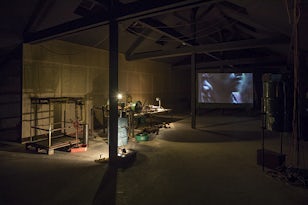
NM: Whereas a lot of the other work opens up into the world – by looking at mining or renewable energy as a kind of content – with this work I was thinking about my own means of production and working within an institution on a budget, and the contradictions that come about through something like Bitcoin, which has never really been able to detach itself from the constructs of capitalism and finance. Bitcoin is dehumanised labour that is very much machine based and virtual, yet it’s highly contingent on sucking heaps of natural minerals from the earth. What I’m doing is kind of ‘parasiting’ off the university, and it was only through looking at money and my estrangement of money that the value of the production of my work can be seen in a bigger context. This is a first step in a series of transactions and transformations that will take place. The kind of product that I’ve produced, such as these photos, is the first thing that I will use as a readymade for further exchanges and to get myself out of an ‘eco-moral debt’ due to all the energy I’ve consumed for this exhibition.
GC: As there is a finite number of Bitcoins people already know about many coins that have been lost, which are now referred to as ‘zombie coins’. This has led various commentators to propose that the next phase of Bitcoin mining will be an attempt to find these ‘zombie coins’. However one analyst said that the encryption is so complex this would be ‘infeasible until computers are built from something other than matter and occupy something other than space.’03
NM: Well the fact is that Bitcoin is very much a product of the development of the algorithm, which is both a subtext for the work and is something kind of hovering in the background for me at the moment, the idea that perhaps that crypto-currency will become something that is so advanced that perhaps one day computers will trade with each other and gain more economic power in the world than humans. I think in many ways that’s a possibility.
Footnotes
-
‘Limits to Growth’, a touring survey exhibition including this eponymous work, has been shown at Monash University Museum of Art, Melbourne (from 20 July to 17 September 2016); the Institute of Modern Art, Brisbane (from 29 October to 18 December 2016); and currently KW Institute for Contemporary Art, Berlin from 2 June to 13 August 2017); this interview was conducted on Tuesday 2 August 2016 in Melbourne.
-
See ‘Bitcoin Miners Face Fight for Survival as New Supply Halves’, Fortune, 8 July 2016, available at http://fortune.com/2016/07/08/bitcoin-miners-fight-survival-supply-halves/.
-
Bruce Schneier, quoted in ‘The £625m lost forever – the phenomenon of disappearing Bitcoins’, Telegraph, 23 January 2015, available at http://www.telegraph.co.uk/technology/news/11362827/The-625m-lost-forever-the-phenomenon-of-disappearing-Bitcoins.html. Schneier rules out an attempt to crack a 256-bit key, of the type used by Bitcoin, by referring to the laws of physics: ‘such is the magnitude of the problem. Even an impracticably large computer consuming all the energy outputted by the sun couldn’t count the number of possible combinations in several decades.’
